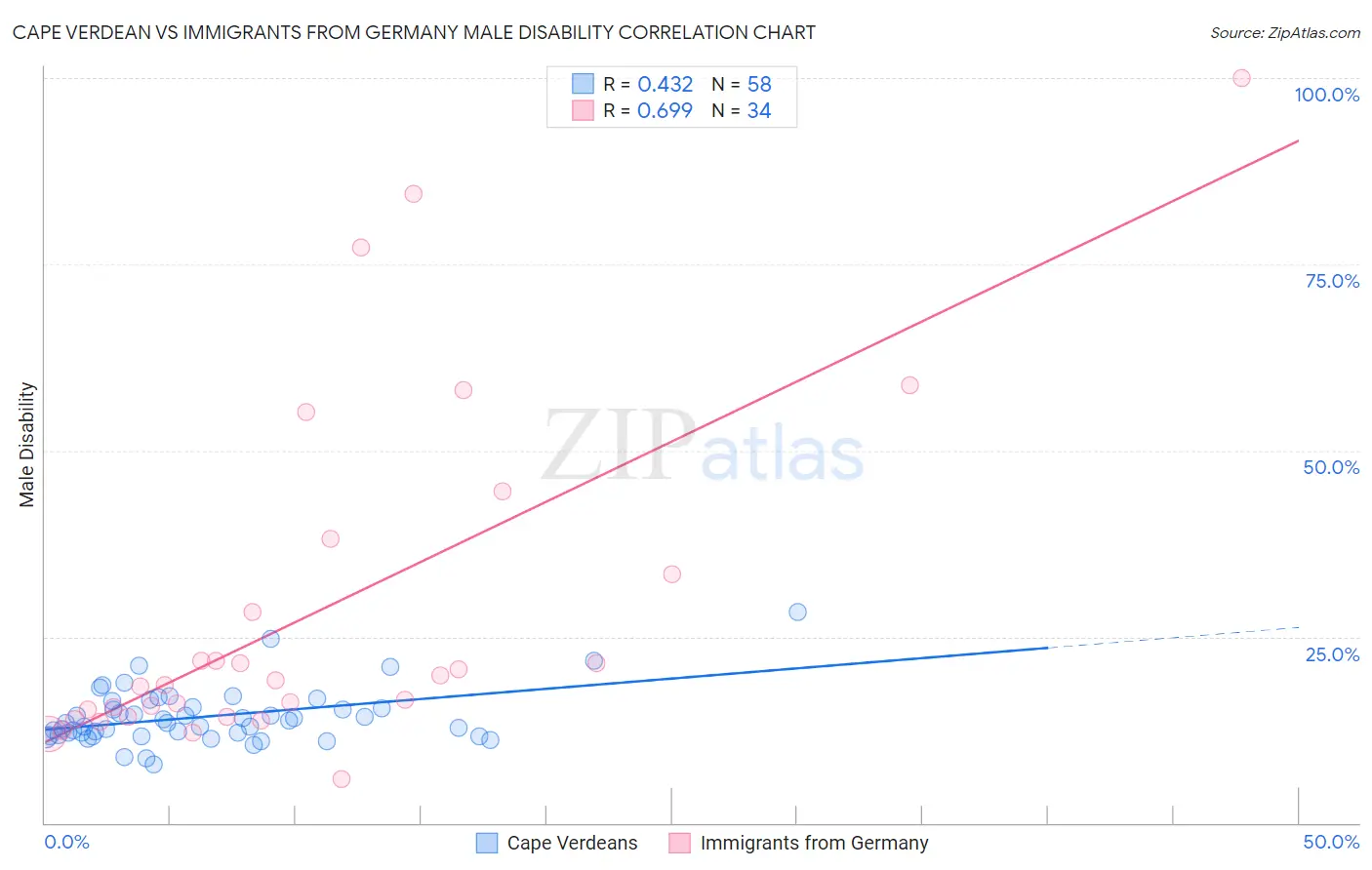Cape Verdean vs Immigrants from Germany Male Disability
COMPARE
Cape Verdean
Immigrants from Germany
Male Disability
Male Disability Comparison
Cape Verdeans
Immigrants from Germany
12.8%
MALE DISABILITY
0.0/ 100
METRIC RATING
287th/ 347
METRIC RANK
12.3%
MALE DISABILITY
0.1/ 100
METRIC RATING
267th/ 347
METRIC RANK
Cape Verdean vs Immigrants from Germany Male Disability Correlation Chart
The statistical analysis conducted on geographies consisting of 107,575,167 people shows a moderate positive correlation between the proportion of Cape Verdeans and percentage of males with a disability in the United States with a correlation coefficient (R) of 0.432 and weighted average of 12.8%. Similarly, the statistical analysis conducted on geographies consisting of 463,850,065 people shows a significant positive correlation between the proportion of Immigrants from Germany and percentage of males with a disability in the United States with a correlation coefficient (R) of 0.699 and weighted average of 12.3%, a difference of 4.0%.

Male Disability Correlation Summary
| Measurement | Cape Verdean | Immigrants from Germany |
| Minimum | 7.8% | 5.9% |
| Maximum | 28.3% | 100.0% |
| Range | 20.5% | 94.1% |
| Mean | 14.3% | 28.5% |
| Median | 13.4% | 18.8% |
| Interquartile 25% (IQ1) | 11.7% | 14.2% |
| Interquartile 75% (IQ3) | 15.6% | 33.3% |
| Interquartile Range (IQR) | 3.8% | 19.1% |
| Standard Deviation (Sample) | 3.7% | 23.0% |
| Standard Deviation (Population) | 3.7% | 22.7% |
Demographics Similar to Cape Verdeans and Immigrants from Germany by Male Disability
In terms of male disability, the demographic groups most similar to Cape Verdeans are Scottish (12.8%, a difference of 0.070%), Welsh (12.7%, a difference of 0.12%), Spanish (12.7%, a difference of 0.13%), German (12.7%, a difference of 0.39%), and Irish (12.7%, a difference of 0.40%). Similarly, the demographic groups most similar to Immigrants from Germany are Portuguese (12.3%, a difference of 0.13%), Czechoslovakian (12.3%, a difference of 0.13%), Spaniard (12.3%, a difference of 0.21%), Scandinavian (12.3%, a difference of 0.40%), and Hmong (12.5%, a difference of 1.6%).
| Demographics | Rating | Rank | Male Disability |
| Immigrants | Germany | 0.1 /100 | #267 | Tragic 12.3% |
| Portuguese | 0.1 /100 | #268 | Tragic 12.3% |
| Czechoslovakians | 0.1 /100 | #269 | Tragic 12.3% |
| Spaniards | 0.1 /100 | #270 | Tragic 12.3% |
| Scandinavians | 0.1 /100 | #271 | Tragic 12.3% |
| Hmong | 0.0 /100 | #272 | Tragic 12.5% |
| Native Hawaiians | 0.0 /100 | #273 | Tragic 12.5% |
| Hopi | 0.0 /100 | #274 | Tragic 12.5% |
| Fijians | 0.0 /100 | #275 | Tragic 12.6% |
| Africans | 0.0 /100 | #276 | Tragic 12.6% |
| Finns | 0.0 /100 | #277 | Tragic 12.6% |
| Central American Indians | 0.0 /100 | #278 | Tragic 12.7% |
| Slovaks | 0.0 /100 | #279 | Tragic 12.7% |
| Dutch | 0.0 /100 | #280 | Tragic 12.7% |
| Sioux | 0.0 /100 | #281 | Tragic 12.7% |
| Irish | 0.0 /100 | #282 | Tragic 12.7% |
| Germans | 0.0 /100 | #283 | Tragic 12.7% |
| Spanish | 0.0 /100 | #284 | Tragic 12.7% |
| Welsh | 0.0 /100 | #285 | Tragic 12.7% |
| Scottish | 0.0 /100 | #286 | Tragic 12.8% |
| Cape Verdeans | 0.0 /100 | #287 | Tragic 12.8% |